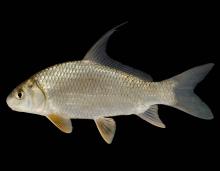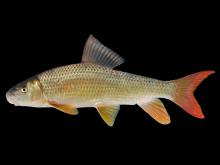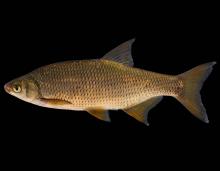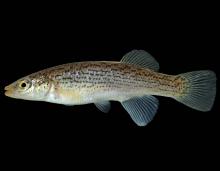Fishes
Media

Species Types
Scientific Name
Carpiodes cyprinus
Description
Like our other carpsuckers, the quillback has a deep, rather thick body and a long, sickle-shaped dorsal fin. This silvery, hump-backed fish is widely distributed in Missouri.
Media

Species Types
Scientific Name
Catostomus commersonii
Description
The white sucker has fine scales and a short dorsal fin. The lips are covered with small bumps. A small-creek fish that occurs nearly statewide, but absent from the Bootheel lowlands and the southeastern Ozarks.
Media

Species Types
Scientific Name
Moxostoma erythrurum
Description
The golden redhorse is a smaller-bodied sucker with large scales and a short dorsal fin. It occurs in Ozark and northeast Missouri streams.
Media

Species Types
Scientific Name
Moxostoma carinatum
Description
The river redhorse occurs throughout the Ozarks but is seldom common. It inhabits pools of clear, medium-sized to large streams with gravelly or rocky bottoms and continuous strong flow.
Media

Species Types
Scientific Name
Moxostoma macrolepidotum
Description
The shorthead redhorse is the most widely distributed redhorse sucker in Missouri, occurring nearly statewide. No other Missouri redhorse is as adaptable in its habitat requirements. Many specimens have a pea-shaped swelling on the upper lip.
Media

Species Types
Scientific Name
Notemigonus crysoleucas
Description
The golden shiner is a deep-bodied minnow with a greenish-olive back and a faint dusky stripe along the midline. It has a fleshy keel along the midline of the belly. It is widespread in Missouri.
Media

Species Types
Scientific Name
Nocomis biguttatus
Description
The hornyhead chub is a moderately large, slender minnow with a rather large, nearly horizontal mouth. Males commonly have bony projections on top of the head. Occurs in clear Ozark streams with permanent flow and clean gravel.
Media

Species Types
Scientific Name
Fundulus catenatus
Description
The northern studfish is common and widely distributed in every principal Ozark stream system except the Neosho. Males in spawning coloration are some of our prettiest topminnows.
Media

Species Types
Scientific Name
Dorosoma petenense
Description
The threadfin shad occurs in the Mississippi River and its tributaries. It also occurs in mainstem reservoirs of the White River Basin and in Montrose Lake and the South Grand River in Henry County.
Media

Species Types
Scientific Name
Hiodon tergisus
Description
Mooneyes are silvery, flat-sided fishes with large eyes and prominent teeth on the jaws, roof of the mouth, and tongue. A fleshy keel runs along the midline of the belly. The eye is silvery and larger than the goldeye’s.
See Also


Media

Species Types
Scientific Name
Amphiuma tridactylum
Description
The three-toed amphiuma is an eel-like, completely aquatic salamander. It has very small forelimbs and hind limbs, each with three tiny toes. In Missouri it’s found only in the Bootheel region.
Media

Species Types
Scientific Name
Siren intermedia nettingi
Description
The western lesser siren is an eel-like, aquatic salamander with external gills, small eyes, small forelimbs with four toes, and no hind limbs. In Missouri, it’s found mostly in the Bootheel and northward in counties near the Mississippi River.
About Fishes in Missouri
Missouri has more than 200 kinds of fish, more than are found in most neighboring states. Fishes live in water, breathe with gills, and have fins instead of legs. Most are covered with scales. Most fish in Missouri “look” like fish and could never be confused with anything else. True, lampreys and eels have snakelike bodies — but they also have fins and smooth, slimy skin, which snakes do not.





















